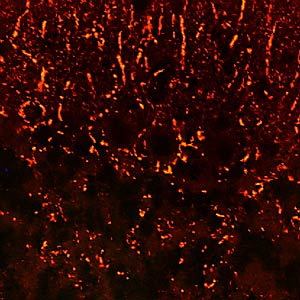Antibodies
| Rabbit polyclonal antibody to Synaptophysin | |
|---|---|
 Immunohistochemical detection of Synaptophysin in rat cerebellum. Tissue was fixed with 4% formaldehyde and cut into 10 μm thick cryostat sections. Tissue was incubated with rabbit polyclonal antibody to Synaptophysin at 5 μg/mL overnight at 4°C followed by incubation with Donkey anti-rabbit Rhodamine Red conjugated secondary antibodies at 1:200. Immunohistochemical detection of Synaptophysin in rat cerebellum. Tissue was fixed with 4% formaldehyde and cut into 10 μm thick cryostat sections. Tissue was incubated with rabbit polyclonal antibody to Synaptophysin at 5 μg/mL overnight at 4°C followed by incubation with Donkey anti-rabbit Rhodamine Red conjugated secondary antibodies at 1:200. Nuclei of keratinocytes were counterstained with DAPI (blue) |
 |
| Formulation | Lyophilized powder |
| Purification | Affinity purified |
| Host Species | Rabbit |
| Unit Size: | 50 µg |
| Immunogen | Synthetic peptide |
| Sequence: | MLLLADMDVVNQLVAGGQFRVVKEPLGFVKVLQWVFAIFAFATCGSYSGE |
| Alternative Names | Major synaptic vesicle protein p38. |
| Accession Number: | P08247 |
| Gene Symbol | SYP |
| Accession URL: | http://www.uniprot.org/uniprot/P08247 |
| Function: Synaptophysin (p38) is an integral membrane protein of small synaptic vesicles in brain and endocrine cells. |
|
| Applications: | Immunohistochemistry (IHC), Immunocytochemistry (ICC), Western Blotting (WB). |
| Working Dilution for Immunofluorescence (ICC): | 5 – 15 µg/mL |
| Working Dilution for Immunohistochemistry (IHC): | 5 – 10 µg/mL |
| Working Dilution for Western Blottin (WB): | 1 µg/mL |
| IHC Positive control: | Brain, spinal cord, neuroendocrine cells |
| Specificity: | Confirmed by WB. |
| Cross-reactivity: | Human; mouse; rat |
| Reconstitution: | Reconstitute in 0.05 mL of PBS (pH 7.4) to achieve an antibody concentration of 1000 µg/mL. Centrifuge to remove any insoluble material. |
| Storage / Stability: | At least 12 months after purchase at 2 - 4°C. After reconstitution, aliquot and store at -20°C for a higher stability and at 4°C with an appropriate antibacterial agent. Avoid freeze-thaw cycles. |
References
|
|
